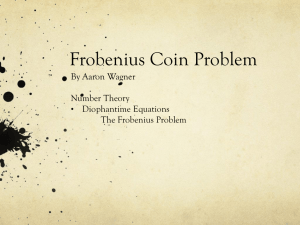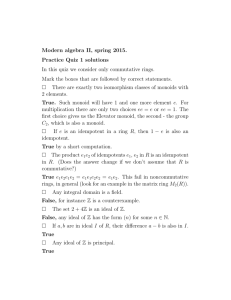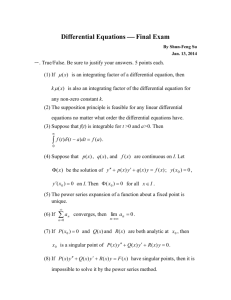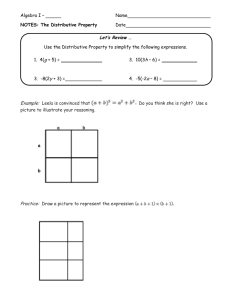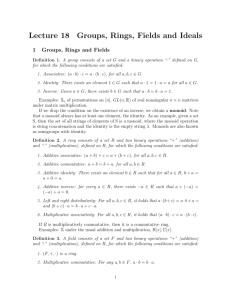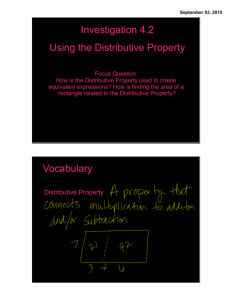THE FROBENIUS RELATIONS MEET LINEAR DISTRIBUTIVITY J.M. EGGER
advertisement
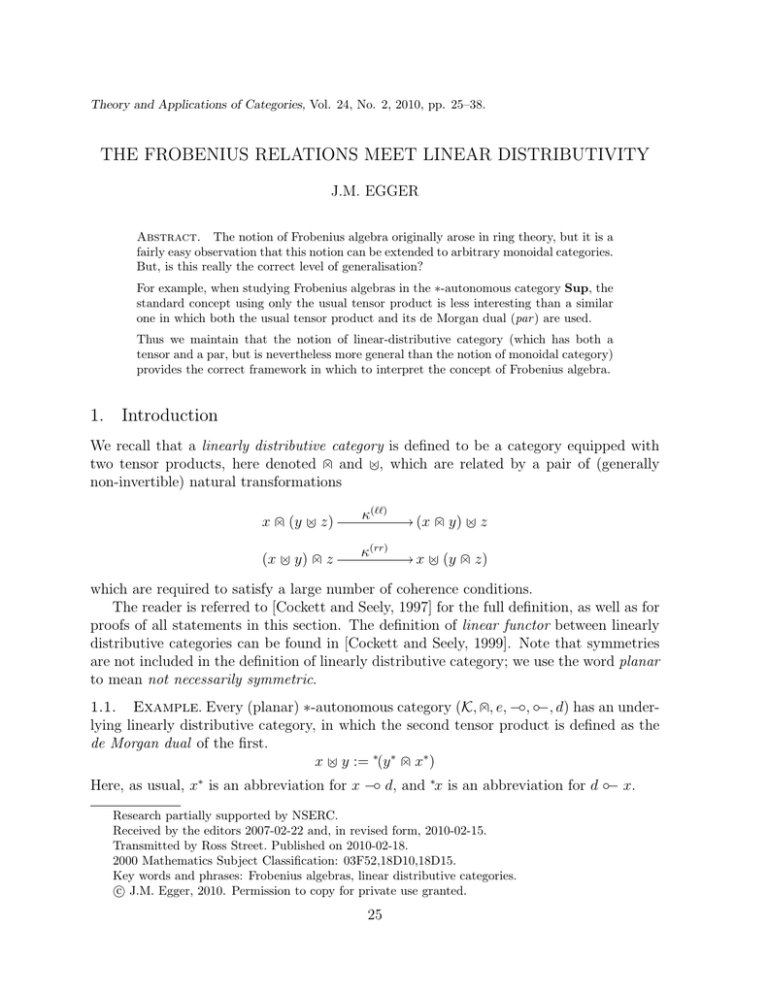
Theory and Applications of Categories, Vol. 24, No. 2, 2010, pp. 25–38.
THE FROBENIUS RELATIONS MEET LINEAR DISTRIBUTIVITY
J.M. EGGER
Abstract. The notion of Frobenius algebra originally arose in ring theory, but it is a
fairly easy observation that this notion can be extended to arbitrary monoidal categories.
But, is this really the correct level of generalisation?
For example, when studying Frobenius algebras in the ∗-autonomous category Sup, the
standard concept using only the usual tensor product is less interesting than a similar
one in which both the usual tensor product and its de Morgan dual (par ) are used.
Thus we maintain that the notion of linear-distributive category (which has both a
tensor and a par, but is nevertheless more general than the notion of monoidal category)
provides the correct framework in which to interpret the concept of Frobenius algebra.
1. Introduction
We recall that a linearly distributive category is defined to be a category equipped with
× and ∪
× , which are related by a pair of (generally
two tensor products, here denoted ∩
non-invertible) natural transformations
× (y ∪
× z)
x∩
× y) ∩
× z
(x ∪
κ(``)
κ(rr)
/
/
× y) ∪
× z
(x ∩
× (y ∩
× z)
x∪
which are required to satisfy a large number of coherence conditions.
The reader is referred to [Cockett and Seely, 1997] for the full definition, as well as for
proofs of all statements in this section. The definition of linear functor between linearly
distributive categories can be found in [Cockett and Seely, 1999]. Note that symmetries
are not included in the definition of linearly distributive category; we use the word planar
to mean not necessarily symmetric.
× , e, −◦, ◦−, d) has an under1.1. Example. Every (planar) ∗-autonomous category (K, ∩
lying linearly distributive category, in which the second tensor product is defined as the
de Morgan dual of the first.
× y := ∗(y ∗ ∩
× x∗ )
x∪
Here, as usual, x∗ is an abbreviation for x −◦ d, and ∗x is an abbreviation for d ◦− x.
Research partially supported by NSERC.
Received by the editors 2007-02-22 and, in revised form, 2010-02-15.
Transmitted by Ross Street. Published on 2010-02-18.
2000 Mathematics Subject Classification: 03F52,18D10,18D15.
Key words and phrases: Frobenius algebras, linear distributive categories.
c J.M. Egger, 2010. Permission to copy for private use granted.
25
26
J.M. EGGER
× x∗ ) ∼
× ∗x)∗ holds in any (planar) ∗-autonomous category, so
(Note that ∗(y ∗ ∩
= ( ∗y ∩
the asymmetry present in the definition above is only one of appearance.)
In particular, a boolean algebra may be viewed as a linearly distributive category with
× = ∧ and ∪
× = ∨.
∩
One of the mount profound and useful observations made in [Cockett and Seely, 1997]
is that what one might call duality theorems in a (planar) ∗-autonomous category can be
characterised in terms of its underlying linearly distributive structure.
× , e, −◦, ◦−, d) be a (planar) ∗-autonomous category, and sup1.2. Theorem. Let (K, ∩
pose that we are given a pair of arrows
θ
xo
× y
Let x ∩
γ
/
ϕ
/∗
y.
d denote the transpose of θ, and τ the composite
p
e
ϕq
/ ∗y
−◦ x
∼
/
× x.
y∪
Then θ and ϕ are inverse to each other if and only if the following diagrams commute.
× e
x∩
× τ
ι∩
/
× (y ∪
× x)
x∩
κ(``)
υ
(lti1 )
(r)
× y) ∪
× x
(x ∩
x
υ
× y
e∩
/
(`) −1
× ι /
τ∩
× y
× x) ∩
(y ∪
× ι
γ∪
× x
d∪
κ(rr)
υ
(lti2 )
(`)
y
υ
(r) −1
× (x ∩
× y)
y∪
/
× γ
ι∪
× d
y∪
(Here we abuse notation by using the same symbol to denote both of the left-unit isomorphisms; similarly, the right-unit isomorphisms.)
THE FROBENIUS RELATIONS MEET LINEAR DISTRIBUTIVITY
1.3.
27
Definitions.
× , e, ∪
× , d)
1. A pair of arrows in a linearly distributive category (K, ∩
γ
× y
x∩
/d
τ
e
/
× x
y∪
τ1
/
× x
y∪
τ2
/
× y
x∪
which satisfies (lti1 ) and (lti2 ) is called a linear adjoint.
2. A pair of linear adjoints
× y
x∩
× x
y∩
γ1
/d
e
γ2
/d
e
is called a cyclic linear adjoint.
1.4. Remark. It is to be emphasised that any monoidal category (K, , i) can be re× = = ∪
× , e = i = d, κ(rr) = α,
garded as a linearly distributive category by choosing ∩
and κ(``) = α−1 .
In this sense, linearly distributive categories are actually more general than monoidal
categories and when, as here, duality theory is at the centre of one’s attention, this is often
a useful point of view: that monoidal categories are merely degenerate linearly distributive
categories.
Note that in the strict degenerate case, the diagrams defining linear adjoint reduce to
the more usual triangle identities.
1.5. Lemma. In an arbitrary linearly distributive category, each half of a linear adjoint
determines the other in the sense that, if
× y
x∩
× y
x∩
γ1
/
d
e
γ2
/
d
e
τ1
/
× x
y∪
τ2
/
× x
y∪
are linear adjoints, then (γ1 = γ2 ) ⇐⇒ (τ1 = τ2 ).
2. Linear points and Frobenius monoids
× , e, ∪
× , d) shall denote an arbitrary linearly disThroughout the next two sections (K, ∩
tributive category.
× , e); the
It shall be our convention that: the term monoid refers to a monoid in (K, ∩
×
term comonoid refers to a comonoid in (K, ∪, d); and, the term monoid/comonoid pair
refers to a monoid and a comonoid (in the senses above) which have the same underlying
object.
28
J.M. EGGER
2.1. Lemma. Let M = (m, µ, η) be a monoid, (x, σ (`) ) a left M -object, and (y, σ (r) ) a
right M -object; then the maps
× (x ∪
× y)
m∩
× y) ∩
× m
(x ∪
κ(``)
κ(rr)
/
/
× x) ∪
× y
(m ∩
× ι
σ (`) ∪
/x∪
× y
× (y ∩
× m)
x∪
× σ (r)
ι∪
/x∪
× y
× y.
define a two-sided action of M on x ∪
Proof. We shall prove only the left/right-compatibility diagram, sometimes also known
as middle associativity, as an illustration.
α
× (x ∪
× y)) ∩
× m
(m ∩
× ι
κ(``) ∩
× y) ∩
× m
(x ∪
κ(rr)
× ((x ∪
× y) ∩
× m)
m∩
× κ(rr)
ι∩
× x) ∪
× y) ∩
× m
((m ∩
× ι) ∩
× ι
(σ (`) ∪
/
VVVV
VVVVκ(rr)
VVVV
VVVV
VV+
(nat)
(coh)
× (x ∪
× (y ∩
× m))
m∩
hh
κhhhhhhhhh
h
hh
hs hhh
(``)
× (ι ∪
× σ (r) )
ι∩
× x) ∪
× (y ∩
× m)
× (x ∪
× y)
(m ∩
(nat)
m∩
VVVV
VVVV
VVVV
VVVV
κ(``)
VV+
× σ (r)
ι∪
× x) ∪
× y
(m ∩
× σ (r)
σ (`) ∪
h
hhhh
hhhh
h
h
h
hhh
s hhh σ (`) ∪
h
× ι
× (y ∩
× m)
x∪
V
VVVV
VVVV
VVVV
VVVV
VVVV
× σ (r)
ι∪
+
× y
x∩
hhhh
hhhh
h
h
h
h
hhhhσ (`) × ι
hs hhh
∪
The remainder is left as an exercise.
2.2. Remark. In (the linearly distributive category arising from) a (planar) ∗-autonomous
× , e, −◦, ◦−, d), we have canonical isomorphisms x∗ −◦ y ∼
× y ∼
category (K, ∩
=x∪
= x ◦− ∗y.
× y coincides the usual one
In this case, the left (right) m-action we have just defined on x ∪
∗
∗
on x ◦− y (respectively, x −◦ y). But in an arbitrary (left- and right-) closed monoidal
category, there would seem to be no way of expressing the idea that these left- and rightactions combine to form a two-sided action.
For the most part, we shall be interested in only the following cases of Lemma 2.1, and
their duals: if M = (m, µ, η) is a monoid, then of course m carries a canonical two-sided
M -action; and so any two-sided action on x induces canonical two-sided actions on both
× m and m ∪
× x.
x∪
This observation is necessary to make the following definition type correctly.
2.3.
Definitions.
× , e, ∪
× , d) consists of:
1. A cyclic nuclear monoid in (K, ∩
(a) a monoid M = (m, µ, η);
THE FROBENIUS RELATIONS MEET LINEAR DISTRIBUTIVITY
29
(b) a comonoid G = (g, δ, ε);
(c) a two-sided M -action (σ (`) , σ (r) ) on g; and
(d) a two-sided G-coaction (θ(`) , θ(r) ) on m;
such that:
(e) m
θ(`)
× g
(f ) m ∩
/
× m and m
g∪
σ (`)
/
θ(r)
× m
g and g ∩
/
× g are M -equivariant; and
m∪
σ (r)
/
g are G-coequivariant.
× , e, ∪
× , d) is a cyclic nuclear monoid with m = g, σ (`) =
2. A Frobenius monoid in (K, ∩
µ = σ (r) , and θ(`) = δ = θ(r) .1
× , e, ∪
× , d) is the same thing as a linear
2.4. Theorem. A cyclic nuclear monoid in (K, ∩
× , e, ∪
× , d)—i.e., a linear functor 1 −→ (K, ∩
× , e, ∪
× , d).
point of (K, ∩
A Frobenius monoid is the same thing as a monoid/comonoid pair (m, µ, η, δ, ε) which
satisfy the linear Frobenius relations depicted below.
κ(``)
× (m ∪
× m)
m∩
O
× m
m∩
δ
ι
× m) ∪
× m
(m ∩
× ι
µ∪
(lfr1 )
× δ
ι∩
×
∩
/
× m) ∩
× m
(m ∪
µ
/m
/
δ
× m
m∪
O
× µ
ι∪
(lfr2 )
κ(rr)
/
× (m ∩
× m)
m∪
Proof. It follows directly from the definition of linear functor that a linear point consists of: a monoid M = (m, µ, η), a comonoid G = (g, δ, ε), and maps σ (`) , σ (r) , θ(`) , θ(r)
whose sources and targets match those given in the definition of cyclic nuclear monoid.
Therefore all that remains to show is that the eighteen coherence conditions required of
σ (`) , σ (r) , θ(`) , θ(r) by the definition of linear functor are (collectively) equivalent to the
conditions placed on them by the definition of cyclic nuclear monoid.
In fact, Definition 2.3 also requires that σ (`) , σ (r) , θ(`) and θ(r) satisfy a total of eighteen
diagrams:
1. five diagrams for σ (`) , σ (r) being an M -action;
2. five diagrams for θ(`) , θ(r) being a G-coaction;
3. four diagrams for θ(`) , θ(r) being M -equivariant; and
1
I have two suggestions for replacing the phrase Frobenius monoid with something shorter: Frobenium
and ambimonoid—indeed, I should like to propose the term ambimonoidal as a synonym for linearly
distributive so that we can speak of ambimonoids in an ambimonoidal category.
30
J.M. EGGER
4. four diagrams for σ (`) , σ (r) being G-coequivariant.
We claim that the two sets of conditions are not merely equivalent, but actually equal.
To demonstrate this claim, we need merely identify the five symmetry-based groupings
which appear in [Cockett and Seely, 1999, Definition 1]. These are as follows:
1. the four (co)unit diagrams;
2. the four (co)associativity diagrams;
3. the two left/right-compatibility diagrams;
4. the four same-parity (co)equivariance diagrams—i.e., the left equivariance of θ(`) ,
the right equivariance of θ(r) , the left coequivariance of σ (`) and the right coequivariance of σ (r) ;
5. the remaining four (co)equivariance diagrams.
(What distinguishes the same-parity (co)equivariance diagrams is that, in each case, they
contain an alternating ternary string: either mgm or gmg—for an example, see below.)
Turning to the case of Frobenius monoids, we see that the first ten diagrams (according
to either grouping) are trivial; the remaining eight diagrams collapse to two.
Consider, for example, the M -equivariance of θ(`) . In general, this states that the
diagrams
× m
m∩
× θ (`) /
ι∩
× (g ∪
× m)
m∩
µ
m
θ
(`)
/
× ι /
θ(`) ∩
× m) ∩
× m
(g ∪
κ(``)
× g) ∪
× m
(m ∩
× m
m∩
× ι
σ (`) ∪
× m
g∪
µ
κ(rr)
× (m ∩
× m)
g∪
m
θ
(`)
/
× µ
ι∪
× m
g∪
commute—but, if g = m, σ (`) = µ and θ(`) = δ, then these reduce to (lfr1 ) and (lfr2 ),
respectively.
Each of the three other pairs of diagrams—the G-coequivariance of σ (`) , that of σ (r) ,
and the M -equivariance of θ(r) —do the same.
(Note that each pair contains one diagram with a κ(``) and one with a κ(rr) —the former
reduces to (lfr1 ) and the latter to (lfr2 ).)
31
THE FROBENIUS RELATIONS MEET LINEAR DISTRIBUTIVITY
× , e, ∪
× , d), the follow2.5. Scholium. For a monoid/comonoid pair (m, µ, η, δ, ε) in (K, ∩
ing are equivalent:
δ
× m is left (m, µ, η)-equivariant;
1. m −→ m ∪
δ
× m is right (m, µ, η)-equivariant;
2. m −→ m ∪
µ
× m −→ m is left (m, δ, ε)-coequivariant;
3. m ∩
µ
× m −→ m is right (m, δ, ε)-coequivariant;
4. m ∩
5. (m, µ, η, δ, ε) is a Frobenius monoid.
In the degenerate case, this fact is well-known and appears, for example, in [Kock, 2004].
3. Duality
In the degenerate case, Frobenius monoids are usually studied in connection with duality
theory, so there should be little surprise that the same is true in the general case. Indeed,
it follows from general results in [Cockett and Seely, 1999] and [Cockett et al., 2000] that
cyclic nuclear monoids and Frobenius monoids must be self-dual. Here we formulate and
prove the same result with somewhat more precision.
3.1. Theorem. If ((m, µ, η), (g, δ, ε), (σ (`) , σ (r) ), (θ(`) , θ(r) )) form a cyclic nuclear monoid,
then the maps
η
e
η
/
e
/
m
m
θ(`)
θ(r)
/
/
× m
g∪
m
×
∪
g
× g
m∩
g
×
∩
m
σ (`)
σ (r)
/
/
g
g
ε
ε
/
d
/
d
form a cyclic linear adjoint.
In particular, if (m, µ, η, δ, ε) is a Frobenius monoid, then
e
η
/
m
δ
/
× m
m∪
× m
m∩
µ
/
m
ε
/
d
form a linear adjoint.
Proof. Each of the four same-parity (co)equivariance diagrams is used once, together
with appropriate (co)unit axioms, to obtain one of the four necessary diagrams.
For instance, the left-equivariance of θ(`) (see proof of Theorem 2.4 above) can be
combined with its left counit axiom and the right unit axiom for µ to produce (lti1 ) for
32
J.M. EGGER
η ; θ(`) and σ (`) ; ε.
× e
m∩
× η
ι∩
× θ (`) /
ι∩
/m∩
× m
× (g ∪
× m)
m∩
κ(``)
µ
υ (r)
× g) ∪
× m
(m ∩
θ
,m
υ (`)
(`)
/
× ι
σ (`) ∪
× m
g∪
/d∪
×
−1
× ι
ε∪
m
3.2. Scholium. By examining the proof of Theorem 3.1, we can derive the following
formula for θ(`) :
× (η ; θ)
ι∩
/m∩
× e
× (g ∪
× m)
m∩
O
υ (r)
−1
m
κ(``)
× g) ∪
× m
(m ∩
θ
(`)
/
× ι
σ (`) ∪
× m
g∪
—but recall from Lemma 1.5, that the composite η ; θ(`) is uniquely determined by σ (`) ; ε.
Thus, the structure of a cyclic nuclear monoid is overdetermined. In particular, θ(`)
is determined, indirectly, by σ (`) and ε.
In the case of a Frobenius monoid in a degenerate linearly distributive category, this
is a celebrated result: the map δ = θ(`) is determined by µ = σ (`) and ε—see, for example,
[Kock, 2004].
3.3. Remark. It is interesting to note that only four of the eight (co)equivariance
conditions are actually used in the proof of Theorem 3.1.
Also interesting is the fact that each linear adjoint is constructed using only one half of
the action/coaction structure. This suggests that there exists a more general notion than
that of cyclic nuclear monoid, for which non-cyclic linear adjoints can be constructed.
The latter idea will be more fully explored in a subsequent paper.
4. Frobenius quantales
>
Throughout the next two sections: E shall denote an arbitrary
S elementary topos; −→
( )
its subobject classifier; P the power-E-object monad, ( , , {}); and Ě = Sup(E) the
33
THE FROBENIUS RELATIONS MEET LINEAR DISTRIBUTIVITY
category of P-algebras—equivalently, the category of (internally) cocomplete ordered Eobjects and (internal) sup-homomorphisms. Henceforth, we shall speak of the objects of
E as if they were sets, and therefore also drop the modifiers internal and internally.
As demonstrated in [Joyal and Tierney, 1984], Ě can be given a symmetric ∗-autonomous
structure, and hence also a (symmetric) linearly distributive structure. (We shall postpone the definition of symmetric linearly distributive category until the next section, as we
× and ∪
× for the
will not need this extra structure until then.) We shall continue to write ∩
two tensor products on Ě, but we shall abuse notation, slightly, by denoting their units by
and op respectively. (Each of these carries a canonical P-algebra structure.) Following
the convention laid out in Example 1.1, x∗ does not denote xop but rather x −◦ op ; we
/ x∗ = ∗x .
write x −y for the canonical isomorphism xop
× also for the canonical map
We write |−| for the forgetful functor Ě −→ Ord(E), ∩
×
∩
|x| × |y|
/
× y|
|x ∩
× , >) is the forgetful monoidal functor (Ě, ∩
× , ) −→ (Ord(E), ×, ).
—hence (|−| , ∩
×
A quantale is a monoid in (Ě, ∩, ). (We shall only consider unital quantales in the
current paper.) Given a quantale (q, µ, η), we write (|q| , N, η) for the corresponding
monoid in (Ord(E), ×, ); in particular, N denotes the composite
×
∩
|q| × |q|
/
× q|
|q ∩
|µ|
/
|q| .
We write → and ← for the left- and right-closed structures on (|q| , N, η), respectively.
We recall that a quantale equipped with a cyclic dualising element is commonly called
a Girard quantale, [Rosenthal, 1990]. (By a (cyclic) dualising element for (q, µ, η), one
actually means a (cyclic) dualising element for (|q| , N, η, →, ←).)
Surprisingly, there does not seem to be a standard (short) name for a quantale equipped
with an arbitrary dualising element; but this proves to be fortunate, in light of the following theorem.
× , , ∪
× , op ) amounts to a quantale equipped
4.1. Theorem. A Frobenius monoid in (Ě, ∩
with a dualising element; equivalently, a ∗-autonomous cocomplete poset.
× , , ∪
× , op ), and let =
Proof. Suppose that (q, µ, η, δ, ε) is a Frobenius monoid in (Ě, ∩
sup ker ε (so that ε = x y ). We will abbreviate ( ) → and ← ( ) to ( )⊥ and ⊥( )
respectively.
By Theorem 3.1
η
/
q
δ
/q∪
×
× q
q∩
q
µ
/
q
ε
/ op
form a linear adjoint. Hence, by Theorem 1.2, the transpose of the latter composite
q
(µ ; ε)r
/ op
◦− q = ∗q
34
J.M. EGGER
is invertible.
But it is easy to check that this transpose equals the map
α 7→ x α⊥ y
since we have
⊥
x α y (β)
=⊥
⇐⇒
⇐⇒
⇐⇒
β ≤ α⊥ = α →
× β) = α N β ≤
µ(α ∩
× β)) = ⊥.
ε(µ(α ∩
×
(This may not look contructive, but it is: we’re just using the universal properties of ∩
and of . Here, ⊥ means ⊥op —i.e., > .)
Moreover, this suffices to demonstrate that is a dualising element, since for posets
we always have (⊥(( )⊥ ))⊥ = ( )⊥ .
The previous arguments are reversible in the sense that if we start with a dualising
µ
ε
/q
/ op
× q
element , then we can define ε = x y , and the composite q ∩
defines half of a linear adjoint. According to Scholium 3.2, there is then a unique δ
× , , ∪
× , op ).
making (q, µ, η, δ, ε) into a Frobenius monoid in (Ě, ∩
We therefore propose that a quantale equipped with a (not necessarily) dualising
element should be called a Frobenius quantale. We shall also use the term Frobenius
locale for a Frobenius quantale whose underlying quantale is a locale; this amounts to a
complete boolean algebra.
× , , ∩
× , ) whose underlying
By way of comparison, note that a Frobenius monoid in (Ě, ∩
quantale is a locale amounts to a power-object, [Pedicchio and Wood, 1999]. Thus, in
a boolean topos, E, Frobenius quantales are more general than Frobenius monoids in
× , , ∩
× , ); but, in non-boolean toposes, neither concept is contained in the other.
(Ě, ∩
5. Canonical cyclicity
× , e, ∪
× , d) is called symWe recall that, by definition, a linearly distributive category (K, ∩
× and ∪
× are equipped with a symmetry, and if these symmetries (which
metric if both ∩
shall both be denoted χ) satisfy one extra coherence condition:
× (y ∪
× z)
x∩
κ(``)
× χ
ι∩
/x∩
× (z ∪
× y)
× y) ∪
× z
(x ∩
χ
/z∪
×
× y)
(x ∩
χ
× χ
ι∪
/
× y) ∩
× x
(z ∪
/z∪
×
κ(rr)
× x).
(y ∩
The following lemma should be fairly obvious, but its proof does utilise this extra
coherence condition, demonstrating the latter’s worth.
35
THE FROBENIUS RELATIONS MEET LINEAR DISTRIBUTIVITY
5.1.
× , e, ∪
× , d) is a symmetric linearly distributive category, and
Lemma. If (K, ∩
γ
× y
x∩
/
d
e
τ
/
× x
y∪
τ
/
× x
y∪
× , e, ∪
× , d), then
is a linear adjoint in (K, ∩
χ
× x
y∩
/
γ
× y
x∩
/
d
e
χ
/x∪
×
y
× , e, ∪
× , d).
is also a linear adjoint in (K, ∩
× , e, ∪
× , d) gives rises to a cyclic linear adjoint.
Briefly, every linear adjoint in (K, ∩
Proof. We can obtain (lti1 ) as follows:
GF
× τ
ι∩
× e
y∩
× χ
ι∩
/y∩
× (x ∪
× y)
× (y ∪
× x)
y∩
χ
(r)
× (y ∩
× x)
y∪
κ(rr)
.y ×
∪
υ (`)
@A
/
@A
υ (r)−1
y
κ(``)
χ
× ι /
τ∩
× x) ∩
× y
(y ∪
× y
e∩
υ
/
/
/ (y ∩
×
χ
× y
x) ∪
× χ
ι∪
× ι
χ∪
× y) ∪
× y
(x ∩
× y)
(x ∩
× γ
ι∪
χ
× d
y∪
/
× ι
γ∪
× y
dBC∪
O
υ (`)−1
and (lti2 ) by a symmetric argument.
× , e, ∪
× , d)
What is, perhaps, not obvious is whether every cyclic linear adjoint in (K, ∩
arises in this way. As we shall see later in this section, the answer turns out to be no.
5.2.
Definitions.
× , e, ∪
× , d) is called canonically cyclic if the diagram
1. A cyclic linear adjoint in (K, ∩
γ1
× y
x∩
χ
/
γ2
× x
y∩
/
d
d
τ1
e
τ2
e
/
/
× x
y∪
χ
× y.
x∪
commutes.
× , e, ∪
× , d) is called canonically cyclic if the cyclic
2. A cyclic nuclear monoid in (K, ∩
linear adjoint described in Theorem 3.1 is so—i.e., if the diagram
e
e
η
η
/m
θ(`)
/m
(r)
θ
/
/
× m
g∪
χ
× g
m∪
× g
m∩
χ
× m
g∩
σ (`)
/
g
σ (r)
/
g
ε
/
d
ε
/
d
36
J.M. EGGER
commutes.
× , e, ∪
× , d) is a Frobenius monoid whose underlying cyclic
3. A Girard monoid in (K, ∩
nuclear monoid is canonically cyclic—i.e., if it satisfies
e
e
η
η
/
δ
/
m
/
δ
m
× m
m∩
/
× m
m∪
χ
χ
× m
m∩
× m
m∪
µ
/
m
µ
/
m
ε
/
d
ε
/
d
5.3. Remark. As a result of Lemmata 1.5 and 5.1, it suffices to check only one of each
pair of diagrams in the definitions above.
From an abstract point of view, the significance of canonically cyclic linear adjoints
× , e, −◦, ◦−, d),
has to do with the fact that in a symmetric ∗-autonomous category (K, ∩
ω
∗
∗
/ x defined as the transpose of the
we have a canonical natural isomorphism x
composite
χ
ε(r) /
/x∩
× x∗
× x
d.
x∗ ∩
(Note that, for us, the term ∗-autonomous category denotes a (left- and right-) closed
monoidal category equipped with a dualising object; and that the term symmetric ∗autonomous category denotes a ∗-autonomous category equipped with a symmetry. Thus
we do not assume in general that x −◦ y = y ◦− x, although this is what frequently occurs
in practice.)
× , e, −◦, ◦−, d) be a symmetric ∗-autonomous category. Then a
5.4. Theorem. Let (K, ∩
× , e, ∪
× , d)
cyclic linear adjoint in (K, ∩
× y
x∩
× x
y∩
γ1
γ2
/
/
d
e
d
e
τ1
/
× x
y∪
τ2
/
× y
x∪
is canonically cyclic if and only if the diagram
x@A
γ2`
/ y∗
ω
/ ∗y
BCO
γ1r
commutes.
Proof. It suffices to show that the composite
× y
x∩
× ι
γ2` ∩
/ y∗ ∩
× y
× ι /∗
ω∩
× y
y∩
ε(`)
/
d
THE FROBENIUS RELATIONS MEET LINEAR DISTRIBUTIVITY
37
equals γ1 .
But the definition of ω amounts to
× y
y∗ ∩
χ
× ι /∗
ω∩
× y
y∩
× y∗
y∩
/
ε(r)
ε(`)
d
and combining this with a naturality square, we obtain
× y
x∩
χ
@A
× x
y∩
× ι
γ2` ∩
/ y∗ ∩
× y
× ι /∗
ω∩
× y
y∩
χ
× γ2`
ι∩
/y∩
× y∗
ε
(`)
ε(`)
/ d.
BCO
γ2
5.5. Remark. The previous theorem is the main reason we have concentrated on symmetries rather than braidings.
ω
/ ∗x
In a braided ∗-autonomous category, we have at least two isomorphisms x∗
which need not be equal; therefore neither is genuinely canonical.
Readers familiar with the classical theory of Frobenius algebras (i.e., Frobenius monoids
in the degenerate linearly distributive category (Vec, , k, , k)) will have already recognised that not every Frobenius monoid is a Girard monoid, and hence that not every
cyclic linear adjoint is canonically cyclic. (Girard monoids in (Vec, , k, , k) go by the
uninspired, and potentially misleading, name symmetric Frobenius algebras.)
For everyone else we offer the following class of counter-examples.
× , , ∪
× , op ) is the same thing as a Girard
5.6. Corollary. A Girard monoid in (Ě, ∩
quantale.
× , , ∪
× , op ) is the same thing
Proof. By the previous theorem, a Girard monoid in (Ě, ∩
as a Frobenius quantale (q, µ, η, δ, ε) such that the diagram
q
q
(µ ; ε)r
(µ ; ε)
`
/ ∗q
/ q∗
commutes.
But we have already shown, in the proof of Theorem 4.1, that the top map equals
α 7→ x α⊥ y ; by a symmetric argument, the bottom map equals α 7→ x ⊥αy .
38
J.M. EGGER
Acknowledgements
The author would like to thank: Rick Blute, Robin Cockett and Robert Seely, for much
encouragement in developing the material of sections 3 and 4; and David Kruml, for
long and interesting conversations which, among other things, provided the impetus for
proving the results of section 5.
References
[Cockett et al., 2000] Cockett, J. R. B., Koslowski, J., and Seely, R. A. G. (2000). Introduction to linear bicategories. Math. Structures Comput. Sci., 10(2):165–203. The Lambek Festschrift: mathematical structures in computer science (Montreal, QC, 1997).
[Cockett and Seely, 1997] Cockett, J. R. B. and Seely, R. A. G. (1997). Weakly distributive categories. J. Pure Appl. Algebra, 114(2):133–173.
[Cockett and Seely, 1999] Cockett, J. R. B. and Seely, R. A. G. (1999). Linearly distributive functors. J. Pure Appl. Algebra, 143(1-3):155–203. Special volume on the occasion
of the 60th birthday of Professor Michael Barr (Montreal, QC, 1997).
[Joyal and Tierney, 1984] Joyal, A. and Tierney, M. (1984). An extension of the Galois
theory of Grothendieck. Mem. Amer. Math. Soc., 51(309):vii+71.
[Kock, 2004] Kock, J. (2004). Frobenius algebras and 2D topological quantum field theories, volume 59 of London Mathematical Society Student Texts. Cambridge University
Press, Cambridge.
[Pedicchio and Wood, 1999] Pedicchio, M. C. and Wood, R. J. (1999). Groupoidal completely distributive lattices. J. Pure Appl. Algebra, 143(1-3):339–350. Special volume
on the occasion of the 60th birthday of Professor Michael Barr (Montreal, QC, 1997).
[Rosenthal, 1990] Rosenthal, K. I. (1990). Quantales and their applications, volume 234
of Pitman Research Notes in Mathematics Series. Longman Scientific & Technical,
Harlow.
Laboratory for Foundations of Computer Science
School of Informatics, University of Edinburgh
Edinburgh EH8 9AB, United Kingdom
Email: jeffegger@yahoo.ca
This article may be accessed at http://www.tac.mta.ca/tac/ or by anonymous ftp at
ftp://ftp.tac.mta.ca/pub/tac/html/volumes/24/2/24-02.{dvi,ps,pdf}
THEORY AND APPLICATIONS OF CATEGORIES (ISSN 1201-561X) will disseminate articles that
significantly advance the study of categorical algebra or methods, or that make significant new contributions to mathematical science using categorical methods. The scope of the journal includes: all areas of
pure category theory, including higher dimensional categories; applications of category theory to algebra,
geometry and topology and other areas of mathematics; applications of category theory to computer
science, physics and other mathematical sciences; contributions to scientific knowledge that make use of
categorical methods.
Articles appearing in the journal have been carefully and critically refereed under the responsibility of
members of the Editorial Board. Only papers judged to be both significant and excellent are accepted
for publication.
Full text of the journal is freely available in .dvi, Postscript and PDF from the journal’s server at
http://www.tac.mta.ca/tac/ and by ftp. It is archived electronically and in printed paper format.
Subscription information. Individual subscribers receive abstracts of articles by e-mail as they
are published. To subscribe, send e-mail to tac@mta.ca including a full name and postal address. For institutional subscription, send enquiries to the Managing Editor, Robert Rosebrugh, rrosebrugh@mta.ca.
Information for authors.
The typesetting language of the journal is TEX, and LATEX2e
strongly encouraged. Articles should be submitted by e-mail directly to a Transmitting Editor. Please
obtain detailed information on submission format and style files at http://www.tac.mta.ca/tac/.
Managing editor. Robert Rosebrugh, Mount Allison University: rrosebrugh@mta.ca
TEXnical editor. Michael Barr, McGill University: barr@math.mcgill.ca
Assistant TEX editor. Gavin Seal, Ecole Polytechnique Fédérale de Lausanne:
gavin seal@fastmail.fm
Transmitting editors.
Clemens Berger, Université de Nice-Sophia Antipolis, cberger@math.unice.fr
Richard Blute, Université d’ Ottawa: rblute@uottawa.ca
Lawrence Breen, Université de Paris 13: breen@math.univ-paris13.fr
Ronald Brown, University of North Wales: ronnie.profbrown (at) btinternet.com
Aurelio Carboni, Università dell Insubria: aurelio.carboni@uninsubria.it
Valeria de Paiva, Cuill Inc.: valeria@cuill.com
Ezra Getzler, Northwestern University: getzler(at)northwestern(dot)edu
Martin Hyland, University of Cambridge: M.Hyland@dpmms.cam.ac.uk
P. T. Johnstone, University of Cambridge: ptj@dpmms.cam.ac.uk
Anders Kock, University of Aarhus: kock@imf.au.dk
Stephen Lack, University of Western Sydney: s.lack@uws.edu.au
F. William Lawvere, State University of New York at Buffalo: wlawvere@acsu.buffalo.edu
Tom Leinster, University of Glasgow, T.Leinster@maths.gla.ac.uk
Jean-Louis Loday, Université de Strasbourg: loday@math.u-strasbg.fr
Ieke Moerdijk, University of Utrecht: moerdijk@math.uu.nl
Susan Niefield, Union College: niefiels@union.edu
Robert Paré, Dalhousie University: pare@mathstat.dal.ca
Jiri Rosicky, Masaryk University: rosicky@math.muni.cz
Brooke Shipley, University of Illinois at Chicago: bshipley@math.uic.edu
James Stasheff, University of North Carolina: jds@math.unc.edu
Ross Street, Macquarie University: street@math.mq.edu.au
Walter Tholen, York University: tholen@mathstat.yorku.ca
Myles Tierney, Rutgers University: tierney@math.rutgers.edu
Robert F. C. Walters, University of Insubria: robert.walters@uninsubria.it
R. J. Wood, Dalhousie University: rjwood@mathstat.dal.ca
